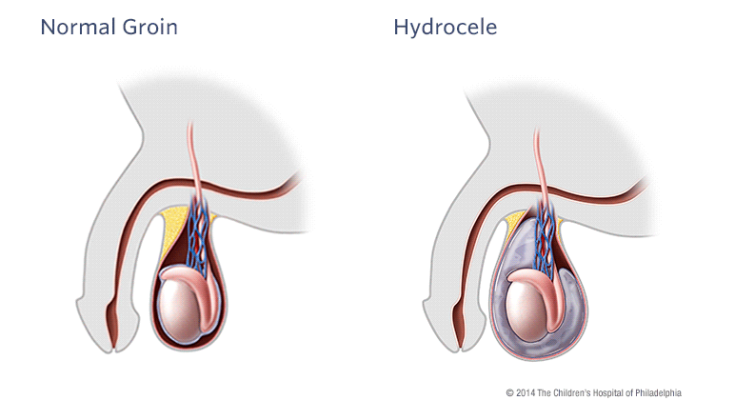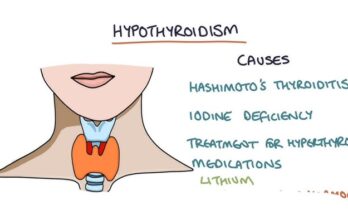Hydrocele Symptoms: Hydrocele is a medical condition characterized by the accumulation of fluid around the testicles, causing swelling in the scrotum.
This condition is generally painless and often goes unnoticed, but it can sometimes lead to discomfort and other complications.
However, understanding the symptoms and causes of hydrocele is crucial for timely diagnosis and treatment.
What is a Hydrocele?
A hydrocele is a medical condition characterized by the accumulation of fluid around a testicle, leading to swelling in the scrotum. This condition can occur in males of any age but is most common in newborns and older men. The fluid buildup is typically painless and may not cause any significant symptoms other than the noticeable swelling.
How It Affects the Body
A hydrocele primarily affects the scrotum, causing it to enlarge. This swelling can sometimes be mistaken for other conditions, such as inguinal hernias or testicular tumors. Although a hydrocele is generally not painful, the increased size of the scrotum can cause discomfort, particularly when sitting or walking. In severe cases, the swelling might lead to a feeling of heaviness or aching in the affected area.
Types of Hydroceles
- Communicating Hydrocele: This type occurs when the channel through which the testicles descend into the scrotum fails to close properly after birth. This allows abdominal fluid to flow in and out of the scrotum, leading to swelling that can vary in size throughout the day.
- Non-Communicating Hydrocele: In this type, the channel is closed, but fluid remains in the scrotum. The fluid buildup does not fluctuate as much and is typically constant. This type is more common in older men and may result from inflammation or injury within the scrotum.
However, understanding hydroceles is crucial for proper diagnosis and treatment. While many cases resolve on their own, persistent or problematic hydroceles may require medical intervention to prevent complications and improve quality of life.
Hydrocele Symptoms
Recognizing these symptoms early can help in seeking timely medical intervention.
Common Symptoms of Hydrocele
- Scrotal Swelling: The most prominent symptom is a painless swelling in one or both sides of the scrotum. This swelling can vary in size and may become more pronounced over time.
- Heaviness in the Scrotum: Many individuals with hydrocele report a feeling of heaviness or fullness in the scrotum, which can be uncomfortable.
- Discomfort or Pain: While hydrocele itself is typically not painful, the swelling can cause discomfort, especially when it increases in size or becomes infected.
- Changes in Size Throughout the Day: The size of the swelling may fluctuate throughout the day, often being smaller in the morning and larger in the evening.
When to Seek Medical Attention
It is crucial to consult a healthcare professional if you notice any of the following:
- Sudden or severe scrotal pain.
- Rapid increase in the size of the swelling.
- Redness, warmth, or tenderness in the scrotal area.
- Fever, which could indicate an infection.
Early medical evaluation is important to rule out other conditions that may present with similar symptoms, such as inguinal hernia or testicular tumors.
Importance of Early Detection and Treatment
Early detection and treatment of hydrocele are vital for several reasons:
- Prevents Complications: Timely intervention can prevent complications such as infections or inguinal hernia, which may require more complex treatments.
- Improves Comfort: Treating hydrocele can alleviate discomfort and improve the quality of life.
- Rule Out Serious Conditions: Early diagnosis helps in ruling out more serious conditions like testicular cancer, which can present with similar symptoms.
If you notice any unusual changes in your scrotal area, don’t hesitate to contact a healthcare provider.
Causes and Risk Factors of Hydrocele
Hydrocele, a fluid-filled sac around a testicle, can occur due to various reasons. Understanding its causes and risk factors can help in early detection and management.
Causes of Hydrocele
Congenital Factors
In infants, hydrocele often results from congenital factors. During fetal development, a sac called the processus vaginalis allows fluid to travel from the abdomen to the scrotum. Normally, this sac closes before birth, but if it remains open, it can lead to a hydrocele.
Developmental Issues in Infants
Developmental issues in infants, such as a patent processus vaginalis, can cause hydroceles. This condition usually resolves on its own within the first year of life but may require medical attention if it persists.
Acquired Causes
In adults, hydroceles can develop due to several acquired causes:
- Injury or Trauma: Any injury or trauma to the scrotal area can lead to the accumulation of fluid, resulting in a hydrocele.
- Infections: Infections such as epididymitis (inflammation of the epididymis) or orchitis (inflammation of the testicle) can cause hydroceles.
- Inflammation: Conditions that cause inflammation in the scrotal area can lead to fluid buildup around the testicles.
- Post-Surgical Complications: Surgery involving the scrotal or groin area, such as hernia repairs, can sometimes result in the formation of a hydrocele.
Risk Factors of Hydrocele
Several factors can increase the risk of developing a hydrocele:
- Age: Infants and older men are more prone to hydroceles.
- Infections: Recurrent infections in the scrotal area can increase the risk.
- Injury: Previous injuries to the groin or scrotum can be a risk factor.
- Surgery: Past surgeries involving the scrotal or groin area can raise the risk of developing a hydrocele.
By understanding these causes and risk factors, individuals can seek timely medical advice and treatment for hydroceles, ensuring better health outcomes.
Diagnosis of Hydrocele
Diagnosing a hydrocele involves a combination of a physical examination and imaging tests to ensure an accurate diagnosis and rule out other conditions.
Physical Examination
During a physical examination, your doctor will check for swelling in the scrotum. They may shine a light through the scrotum (transillumination) to see if the swelling is due to fluid (which is typical of a hydrocele) or if it is solid (which may indicate other issues like tumors or hernias).
Imaging Tests
Imaging tests are crucial for confirming the diagnosis and providing a clear view of the condition.
Ultrasound
An ultrasound is the primary imaging test used to diagnose a hydrocele. This non-invasive test uses sound waves to create detailed images of the scrotum and its contents, helping to distinguish between a hydrocele and other potential problems like hernias or tumors. Ultrasounds are safe, painless, and highly effective in providing a clear diagnosis.
Differential Diagnosis
It’s essential to differentiate a hydrocele from other conditions that can cause similar symptoms, such as hernias or tumors. A thorough differential diagnosis ensures that the correct treatment plan is established.
Distinguishing Hydrocele from Other Conditions
- Hernias: Unlike hydroceles, hernias involve the protrusion of tissue through an opening in the muscle wall. Physical exams and imaging tests like ultrasounds help in differentiating between these two conditions.
- Tumors: Solid masses in the scrotum could indicate tumors. Transillumination during the physical exam can reveal whether the swelling is fluid-filled (hydrocele) or solid. Ultrasound can further distinguish these conditions by providing detailed images of the scrotal contents.
By combining physical examinations with imaging tests, healthcare providers can accurately diagnose hydroceles and differentiate them from other conditions, ensuring effective treatment and management.
Treatment Options for Hydrocele
Here are the treatment options for hydrocele, including medical treatments, surgical options, and post-treatment care and recovery.
Medical Treatments
- Observation: For many adults, especially if the hydrocele is small and not causing symptoms, doctors may recommend a watch-and-wait approach. Regular check-ups will monitor the hydrocele for any changes.
- Aspiration: This procedure involves using a needle to drain the fluid from the hydrocele. It is typically performed under local anesthesia. While aspiration can provide temporary relief, it is not a permanent solution, as the fluid may reaccumulate.
- Sclerotherapy: Often done in conjunction with aspiration, sclerotherapy involves injecting a solution into the sac to prevent fluid from reaccumulating. This is a less invasive option but may need to be repeated if the hydrocele returns.
Surgical Options
- Hydrocelectomy: This is the most common surgical procedure for treating hydrocele. It involves making a small incision in the scrotum or lower abdomen to remove the hydrocele sac. The procedure is typically done under general anesthesia.
- Laparoscopic Surgery: A minimally invasive option, laparoscopic surgery involves making several small incisions and using a camera and special instruments to remove the hydrocele sac. This option often results in shorter recovery times and less post-operative pain.
- Needle Aspiration with Sclerotherapy: This combined procedure involves draining the hydrocele with a needle and then injecting a sclerosing agent to prevent recurrence. It is less invasive than a hydrocelectomy but may not be as effective long-term.
Post-Treatment Care and Recovery
- Rest and Activity: After treatment, especially surgery, rest is crucial. Patients are advised to avoid strenuous activities and heavy lifting for a few weeks. Light activities can be resumed as tolerated.
- Pain Management: Over-the-counter pain relievers like acetaminophen or ibuprofen can help manage discomfort. Prescription pain medications may be provided for a few days after surgery.
- Scrotal Support: Wearing a scrotal support or athletic supporter can help reduce swelling and provide comfort during the recovery period.
- Follow-Up Appointments: Regular follow-up visits with the healthcare provider are important to monitor healing and ensure there are no complications, such as infection or recurrence of the hydrocele.
- Hygiene: Keeping the surgical site clean and dry is essential to prevent infection. Patients should follow their doctor’s instructions on how to care for the incision site.
By understanding the available treatment options and following proper post-treatment care, patients with hydrocele can achieve a good recovery and minimize the risk of complications. Always consult with a healthcare professional to determine the best treatment plan for your specific condition.
Prevention and Management of Hydrocele
Hydrocele is a condition where fluid accumulates around the testicle, leading to swelling in the scrotum. While it is generally not painful, it can cause discomfort and concern. Here’s how you can prevent and manage hydrocele effectively:
Preventive Measures
- Maintain Good Hygiene: Regularly clean the genital area to prevent infections that could lead to hydrocele.
- Protect from Injuries: Wear protective gear during sports or physical activities to avoid trauma to the groin area.
- Treat Infections Promptly: Seek immediate medical attention for infections, particularly those involving the genital or urinary tract.
- Avoid Heavy Lifting: Strenuous activities can increase abdominal pressure, potentially contributing to hydrocele development.
Self-Care Tips
- Wear Supportive Underwear: Use supportive briefs to help alleviate discomfort and support the scrotum.
- Apply Cold Compresses: Reduce swelling and pain by applying ice packs to the affected area for short periods.
- Elevate the Scrotum: When resting, elevate the scrotum with a rolled towel to reduce swelling.
- Stay Hydrated: Drink plenty of fluids to support overall health and reduce the risk of infections.
- Monitor Symptoms: Keep an eye on any changes in the size or discomfort level of the hydrocele and report to your doctor.
By following these preventive measures and self-care tips, you can manage hydrocele effectively and minimize its impact on your daily life. If symptoms persist or worsen, consult a healthcare professional for further evaluation and treatment.
FAQs about Hydrocele
What is a Hydrocele?
A hydrocele is a fluid-filled sac that forms around a testicle, causing swelling in the scrotum. It’s common in newborns but can occur at any age.
What are the Symptoms of a Hydrocele?
The primary symptom of a hydrocele is painless swelling of one or both testicles. In some cases, discomfort may occur due to the size of the swelling.
What Causes a Hydrocele?
Hydroceles in newborns often result from an open inguinal canal that normally closes before birth. In adults, hydroceles can develop due to injury, inflammation, or infection in the scrotum.
How is a Hydrocele Diagnosed?
A hydrocele is typically diagnosed through a physical examination. Doctors may use an ultrasound to confirm the diagnosis and rule out other conditions.
What are the Treatment Options for Hydrocele?
Many hydroceles in infants resolve on their own within the first year of life. For adults, treatment options include observation, aspiration, or surgical removal, especially if the hydrocele is large or causes discomfort.
Can a Hydrocele Lead to Complications?
While hydroceles are generally harmless, they can sometimes indicate an underlying condition, such as an infection or tumor. It’s important to consult a healthcare provider for an accurate diagnosis and appropriate management.
Is Surgery Always Necessary for a Hydrocele?
Surgery is not always necessary. In many cases, especially in children, hydroceles resolve without treatment. However, surgery might be recommended if the hydrocele persists, is large, or causes pain.
Can Hydroceles be Prevented?
There is no sure way to prevent hydroceles, but reducing the risk of injury or infection to the scrotal area may help.
Conclusion
In conclusion, understanding hydrocele is crucial for managing and preventing its symptoms effectively. To recap, hydrocele is a condition characterized by fluid accumulation around the testicle, leading to swelling. Key points to remember include recognizing the common symptoms such as painless swelling, and understanding the potential causes like injury or inflammation. Treatment options range from watchful waiting to surgical intervention, depending on the severity of the condition.
If you experience any symptoms of hydrocele, it is essential to seek medical advice promptly. Early diagnosis and treatment can prevent complications and ensure better health outcomes.
Final thoughts: Staying informed about hydrocele and maintaining regular check-ups can help manage the condition effectively. Practicing good hygiene, avoiding injury, and seeking timely medical care are vital steps in preventing hydrocele. Remember, proactive health management is key to a healthier life.
References
For further reading and to validate the information provided on hydrocele symptoms, we have cited reputable sources below. These resources offer comprehensive insights and additional details.
- Mayo Clinic – Hydrocele: A trusted source for understanding the causes, symptoms, and treatment options for hydroceles.
- Cleveland Clinic – Hydrocele: Detailed information on hydrocele symptoms, diagnosis, and management from a leading healthcare provider.
- Johns Hopkins Medicine – Hydrocele: Expert-reviewed content covering the basics of hydroceles and their clinical implications.
- NHS UK – Hydrocele: Reliable and easy-to-understand information on hydroceles from the UK’s National Health Service.
These links provide valuable, authoritative information to help you better understand hydroceles and their symptoms.


